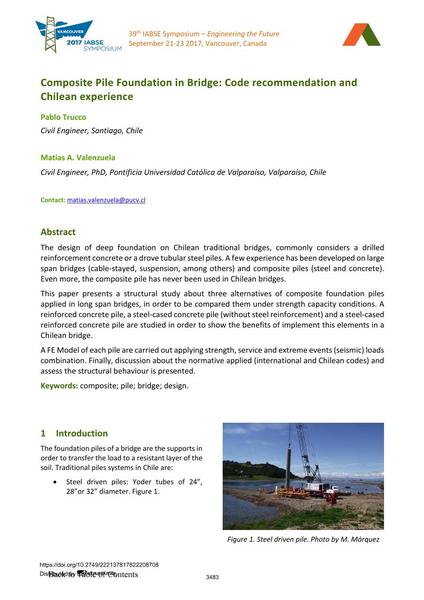Composite Pile Foundation in Bridge: Code recommendation and Chilean experience

|
|
|||||||||||
Bibliografische Angaben
| Autor(en): |
Pablo Trucco
(Civil Engineer, Santiago, Chile)
Matías A. Valenzuela (Civil Engineer, PhD, Pontificia Universidad Católica de Valparaíso, Valparaíso, Chile) |
||||
|---|---|---|---|---|---|
| Medium: | Tagungsbeitrag | ||||
| Sprache(n): | Englisch | ||||
| Tagung: | IABSE Symposium: Engineering the Future, Vancouver, Canada, 21-23 September 2017 | ||||
| Veröffentlicht in: | IABSE Symposium Vancouver 2017 | ||||
|
|||||
| Seite(n): | 3483-3490 | ||||
| Anzahl der Seiten (im PDF): | 8 | ||||
| Jahr: | 2017 | ||||
| DOI: | 10.2749/222137817822208708 | ||||
| Abstrakt: |
The design of deep foundation on Chilean traditional bridges, commonly considers a drilled reinforcement concrete or a drove tubular steel piles. A few experience has been developed on large span bridges (cable-stayed, suspension, among others) and composite piles (steel and concrete). Even more, the composite pile has never been used in Chilean bridges. This paper presents a structural study about three alternatives of composite foundation piles applied in long span bridges, in order to be compared them under strength capacity conditions. A reinforced concrete pile, a steel-cased concrete pile (without steel reinforcement) and a steel-cased reinforced concrete pile are studied in order to show the benefits of implement this elements in a Chilean bridge. A FE Model of each pile are carried out applying strength, service and extreme events (seismic) loads combination. Finally, discussion about the normative applied (international and Chilean codes) and assess the structural behaviour is presented. |
||||
| Stichwörter: |
Entwurf Brücke Verbund Pfahl
|
||||
